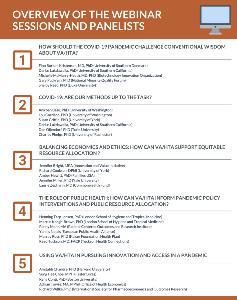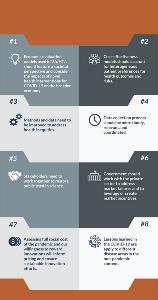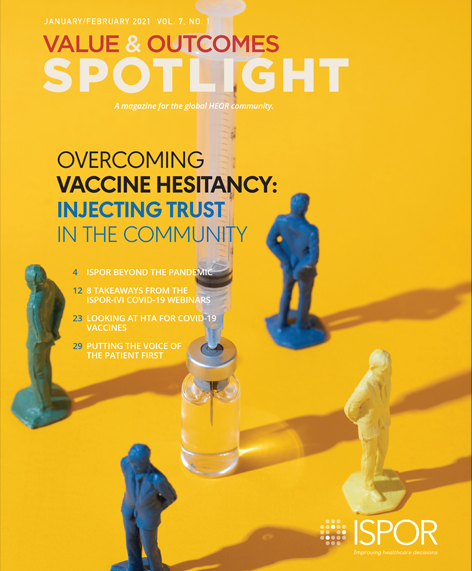Value Assessment in the Age of COVID-19: 8 Takeaways From the ISPOR—IVI COVID Webinar Series
COVID-19 has swept across the globe and disrupted healthcare access as well as the role and pace of scientific inquiry and emphasized the need for global collaboration. As the world races to develop novel technologies to diagnose, treat, and prevent COVID-19, the pandemic has amplified methodological and policy challenges for the health economics and outcomes research (HEOR) community in conducting value assessment and health technology assessment (HTA).
From July to November 2020, ISPOR and the Innovation and Value Initiative (IVI) co-led a 5-part webinar series, “Value Assessment in the Age of COVID-19: Meeting the Challenges.” Experts from diverse disciplines including economics, medicine, epidemiology, public health, and patient advocacy were convened to discuss challenges and potential solutions. A wide range of topics were addressed, including methodologies, health inequity, public health, and pricing and reimbursement strategies (Figure 1).

Each webinar discussion offered numerous insights and important learnings. In reflecting across the series as a whole, several important topics rose to the top. In this article, we outline our 8 key takeaways for value assessment and HTA in the context of COVID-19 (Figure 2).
Figure 2. 8 key takeaways for VA/HTA in the pandemic context.

1. Economic evaluation models used in value assessment and HTA should feature a societal perspective and consider the impacts of novel health interventions for COVID-19 on the broader economy.
Quantitative economic models, most notably cost-effectiveness analysis models, are increasingly used to prioritize the use of health interventions given limited health sector resources. Existing models typically feature an individually focused health system or a “limited” societal perspective. Compared with other diseases, COVID-19 is highly contagious and has sizable impacts on the nonhealth sectors. Due to its significant social and economic impacts, economic models focusing on COVID-19 should be broadened to feature a societal perspective and reflect a comprehensive set of social costs and benefits, as proposed by the Second Panel on the Use of Cost-Effectiveness in Health and Medicine.1-3 In constructing the societal perspective, modelers should consider a broader set of novel value elements, such as fear of contagion and severity of disease, as outlined in the ISPOR Special Task Force on Value Assessment Frameworks.3-4
Along these same lines, existing models typically do not consider the impacts of novel technologies on nonhealth sectors and the broader economy. As novel health interventions are likely to generate gains in all sectors, alternative methodologies that explicitly model the impacts and interactions of novel treatments on aggregate economic indicators such as employment and gross domestic product should be considered. Computable general equilibrium models are promising alternatives, as they enable modelers to include all economic sectors to various degrees of aggregation and disaggregation, depending on which are of the most interest.5
Economic evaluation models are used to support a range of decisions, including those related to pricing, coverage, and utilization. Understanding the impacts of novel treatments on both health and nonhealth sectors is important, but this does not imply that innovators of novel therapies should capture the full value of system-wide gains generated, as discussed below.
2. Cost-effectiveness models should account for heterogeneous patient preferences for health outcomes and risks.
A recent COVID-19 study by Duke University researchers used an experimental design and showed that individuals in American society have diverse preferences regarding social distancing restrictions, infection risks, and economic outcomes.6 These preferences and differing levels of compliance with COVID-19 public health measures reveal that preferences related to health outcomes and risks vary across population subgroups. These heterogeneous preferences matter, especially in terms of how they affect health behaviors such as vaccination uptake and other preventive measures.
Conventional cost-effectiveness analysis estimates often implicitly assume that all individuals have identical and “average” preferences.7 A potential way to consider the impact of heterogeneous risk preferences on cost-effectiveness analysis is the Generalized, Risk-Adjusted Cost-Effectiveness (GRACE) framework—an augmented cost-effectiveness analysis that offers a unifying framework to account for divergent patient preferences alongside quality-adjusted life-years and the usual elements of a cost-effectiveness analysis.7
3. Methods and data need to be improved to address health inequities.
Evolving data from the COVID-19 pandemic highlight its disproportionate impacts in our society, with greater incidence among people of color and those with lower socioeconomic status. Health inequities have been extensively documented across disease states and countries. Value assessment and HTA methods need to be improved and tested to address questions of inequity more thoroughly.
Ensuring that data collection and evidence-generation efforts represent a diverse patient population is the necessary first step. Encouraging participation from underserved communities will allow the sources and magnitudes of disparity to be examined and provide necessary data inputs for methods that address inequity.
Distributional cost-effectiveness analysis is a promising analytical framework that allows decision makers to assess the impacts of various policies on health disparities in addition to the population-level health gains.8
4. Data collection processes should be more timely, relevant, and coordinated.
For models to generate insights that aid real-time decision making, data collection efforts need to be more timely, relevant, and coordinated. In the United States, due to a fragmented healthcare system, data are typically collected and stored by different stakeholders in separate data systems. Although an abundance of data already exists, the challenge is to integrate data on a common platform that promotes interoperability. More communication is needed across stakeholders to coordinate such efforts.
As the world races to develop safe and effective COVID-19 interventions, data collection efforts should be designed for both near-term regulatory approval and longer-term evidence needs. Understanding of COVID-19 is rapidly evolving and data collection efforts should generate long-term, real-world evidence that will enable assessment of novel interventions and preparation for the next pandemic.
Data collectors should also be more active in their outreach efforts, shifting away from a “if we build it, they will come” mentality. With a broad and diverse population pool as their goal, data collectors need to actively reduce barriers to patient participation.
5. Stakeholders need to work together to restore public trust in science.
As shown in many countries, public health interventions are cost-effective solutions to fighting a pandemic. But they only work when a clear message is delivered and the public trusts government institutions and the scientific enterprise.
Globally, adherence to public health guidelines has varied widely. In the United States, the lack of coordination between the federal government and state health departments has contributed to an erosion of trust. Restoring public trust should be a major initiative moving forward, requiring coordinated efforts from the media, health providers, researchers, government, and politicians.
The HEOR community can contribute to restoring the public’s trust in science in several ways. When conducting value assessment and HTA, we should be more transparent about methodologies, key assumptions, and data inputs. We should acknowledge and fully examine the uncertainty in our estimates by conducting sensitivity analyses that use alternative assumptions and data inputs. Efforts should also be made to communicate our methodology and findings to nontechnical, non-HEOR audiences.
6. Government should work with the private sector to address market failures and to leverage or create market incentives.
Government can be instrumental in fighting the current pandemic and future ones, both directly and indirectly. In some instances, governments should directly intervene to address market failures, such as repurposing existing generic medications to fight COVID-19 and developing testing kits. In others, government should support rather than supplant the market mechanism. For incentivizing and distributing novel health technologies, the government should work with the private sector to leverage or create market incentives and structures. For example, instead of committing to the advance purchase of specific products in development, the government can set aside resources and signal to the market that innovations meeting certain value-based criteria will be rewarded.
In evaluating and prioritizing technologies to fight the pandemic, the government should work with the private sector to assess existing and pipeline health technologies and coordinate efforts accordingly. As the pandemic affects every facet of society, a holistic strategy is needed, building on what we know and advancing diagnoses, treatments, and vaccines. Existing value assessment and HTA tools can help evaluate the social and private returns to different innovation efforts and help the government determine whether direct or indirect interventions are required.
Improving these methods and practices can help in evaluating novel health technology and public policy interventions to fight the pandemic, ensure equitable resource allocation, and incentivize long-term scientific innovation for future pandemic preparedness.
7. Assessing the full social cost of the pandemic and our willingness to reward innovations will inform pricing and ensure sustainable innovation efforts.
The emergency regulatory approvals of COVID-19 treatments and vaccines have stirred up debates about pricing. Traditional cost-effectiveness analyses were used to inform the pricing of remdesivir, for example, in some earlier analyses. But as noted previously, conventional cost-effectiveness analysis approaches do not fully consider the impacts of novel health interventions on the broader economy and might not be the most appropriate decision tool in the pandemic context.
To derive prices consistent with the value-based pricing framework, the social cost of the pandemic should be assessed. Recent estimates set the pandemic’s cost to the United States at over $16 trillion, taking into account lost economic growth and health loss.9 Effective novel interventions are likely to generate huge social benefits (inclusive of health and nonhealth gains) and decisions must be made about size and share of the reward to innovators that “save the day.”
Part of the pricing debate centers on the cost-effectiveness threshold, which reflects society’s willingness to pay for novel interventions. Instead of arbitrarily adjusting the existing threshold, policy makers should examine the full social cost and should scale willingness to pay based on appropriate incentives for innovations.
There is little debate that every individual in our society should have access to these novel treatments, regardless of price. But with an eye toward future pandemic preparedness, the signaling effects of current pricing on future innovations must also be considered. Appropriate market incentives should be put in place for innovators to develop technologies that will provide pandemic readiness.
8. Lessons learned in the COVID-19 era apply to different disease areas in the nonpandemic context.
Lessons from the pandemic will have long-lasting impacts on value assessment and HTA methods and practices in our community. Improving these methods and practices can help in evaluating novel health technology and public policy interventions to fight the pandemic, ensure equitable resource allocation, and incentivize long-term scientific innovation for future pandemic preparedness.
Many of the challenges highlighted by COVID-19, such as lack of integrated data and health disparities, are not unique to the pandemic context. COVID-19 provided us with a unique context and a sense of urgency to “pressure-test” our methods and address the existing shortfalls in value assessment and HTA. As we emerge from the pandemic, we should also bear in mind that these learnings apply in the postpandemic era across all disease areas.
Conclusion
ISPOR and the Innovation and Value Initiative launched the webinar series to convene thought leaders from diverse disciplines to explore a range of unique methodological and policy challenges made plain by the pandemic. While much has been learned from this confluence of stakeholder perspectives, addressing these challenges is a longstanding proposition requiring much greater collaboration across our fields. In 2021 and looking forward, ISPOR and the Innovation and Value
Initiative will continue to explore initiatives with the HEOR community to advance the methods and practices of value assessment and HTA.
For complete information about the speakers and specific webinar sessions, please visit the following URL: https://www.ispor.org/conferences-education/education-training/webinars/value-assessment-in-the-age-of-covid-19-meeting-the-challenges
References
1. Garrison LP, Pauly MV, Willke RJ, Neumann PJ. An overview of value, perspective, and decision context: A health economics approach: An ISPOR Special Task Force Report. Value Health. 2018;21(2):124-130. doi:10.1016/j.jval.2017.12.006
2. Garrison LP. Cost-effectiveness and clinical practice guidelines: Have we reached a tipping point? An overview. Value Health. 2016;19(5):512-515. doi:10.1016/j.jval.2016.04.018
3. Sanders GD, Neumann PJ, Basu A, et al. Recommendations for conduct, methodological practices, and reporting of cost-effectiveness analyses: Second panel on cost-effectiveness in health and medicine. JAMA. 2016;316(10):1093-1103. doi:10.1001/jama.2016.12195
4. Lakdawalla DN, Doshi JA, Garrison LP, et al. Defining elements of value in health care—a health economics approach: An ISPOR Special Task Force Report. Value Health. 2018;21(2):131-139. doi:10.1016/j.jval.2017.12.007
5. Keogh-Brown MR, Jensen HT, Edmunds WJ, Smith RD. The impact of Covid-19, associated behaviours and policies on the UK economy: A computable general equilibrium model. SSM - Popul Health. 100651. doi:10.1016/j.ssmph.2020.100651
6. Reed S, Gonzalez JM, Johnson R. Willingness to Accept Tradeoffs among Covid-19 cases, social-distancing restrictions, and economic impact: a nationwide US study. medRxiv. 2020.06.01.20119180. doi:10.1101/2020.06.01.20119180
7. Lakdawalla DN, Phelps CE. Health technology assessment with risk aversion in health. J Health Econ. 2020;72:102346. doi:10.1016/j.jhealeco.2020.102346
8. Asaria M, Griffin S, Cookson R. Distributional cost-effectiveness analysis: a tutorial. Med Decis Making. 2016;36(1):8-19. doi:10.1177/0272989X15583266
9. Cutler DM, Summers LH. The COVID-19 pandemic and the $16 trillion virus. JAMA. 2020;324(15):1495-1496. doi:10.1001/jama.2020.19759
Explore Related HEOR by Topic

